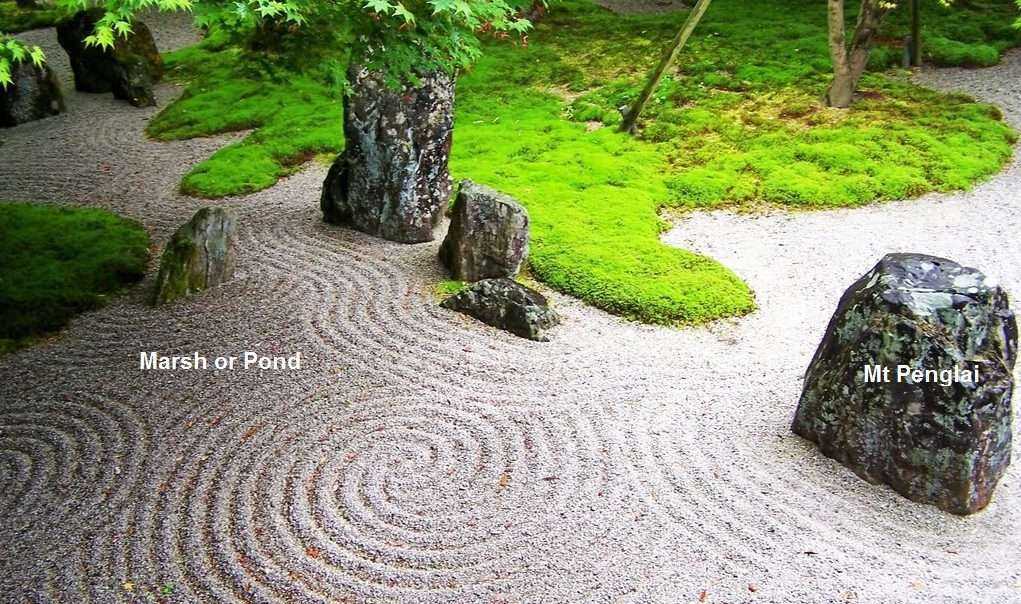Buddhist philosophy teaches that everything in the human mind is merely an illusion. From second to second, year to year, eon to eon, world to world, it is just an illusion. Fortunately, the gullibility of the mortal mind allows it to be easily redirected from negative thinking to positive thinking. As a result, zen gardens and Buddha statues are effective visual aids that have been used for millennia.
The effect of zen gardens and Buddha statues is to create a mental gateway that improves the reality of our existence. The positive energy this creates has real world effects that not only relieve suffering but also improve your immediate environment. In fact, the blissful impact of a positive illusion can literally move mountains.
Do Zen Gardens and Buddha Statues Mix?
Indeed, zen gardens and Buddha statues have positive effects that are time tested. However, these two visual aids use very different methods. A Buddha statue triggers a change in perception that comes from within and zen gardens alter your perception externally.
The primary difference is the positive energy encouraged by a Buddha statue has its roots in virtue and morality. For example, a beautiful Buddha statue is not just a work of art but the zen garden is limited by it’s ambience.
Therefore, by placing a Buddha statue in a zen garden you have reduced it to a mere caricature of the Buddha. Additionally, the ideology behind the zen garden is based in Taoism, not Buddhism. As a result, zen gardens and Buddha statues should remain mutually exclusive.

- The Buddha statue transcends art.
- The virtue and morality inspired by the Buddha is not integral to landscape design.
- Many zen garden Buddhas are a mere caricature of Gautama Buddha.
- Zen garden design is based in Taoism not Buddhism.
The History of Zen Gardens
Although there is a big difference between Japan and China there are also striking similarities. For example, the manual for Japanese rock gardens (zen gardens) is named the Sakuteiki which was written in the 11th century by Tachibana no Toshitsuna.
However, his garden designs in the Sakuteiki are actually based on the Chinese gardens of the Song Dynasty (960 – 1279 ACE). Additionally, the theme of the Song Dynasty gardens is based in Chinese mythology.
In fact, their design concept comes from the mythical mountain island home of the Eight Immortals – Mount Penglai. As a result, the grand illusion of a zen garden is exposed because “Japanese” zen gardens are in fact Chinese!
Zen Garden Design Concepts
The inspirational illusions of zen gardens are created by shaping sand or gravel with special rakes. As a result, ripples create the illusion of water in a dry landscape. Themes using the concept of water include the river concept and also the marsh or pond concept as seen below. Last but not least, rocks are strategically placed to give the illusion of mountains.
It is pretty clear that zen gardens and Buddha statues are not a very pleasing ascetic mix. The illusions of the natural environment are not enhanced by Buddha statues and neither is the zen garden illusion enhanced by a statue.

Below is a photo of a zen garden which is based on the river theme. The main difference is that the sand is raked in a straight line instead of in circles. As a result, it creates the illusion of a river flowing through a natural landscape instead of a pond or marsh.

Sand and gravel have very little in common with water. Nonetheless, the illusion of a natural landscape in an urban environment is a very effective oasis. The result of creating peace and tranquility is positive energy which can work miracles. For example, positive energy can improve physical health, make you more wealthy plus improve personal and professional relationships.
Buddha Statues Provide Internal and External Inspiration
A properly placed Buddha statue can transcend the effects of the best zen gardens. While the zen garden creates a pleasing physical environment in the immediate area, the Buddha statue can make a negative physical environment positive! This is because the Buddha statue meaning encourages the onlooker to draw from within.
As a result, your surrounding environment is transformed from negative to positive by your own perception. It is the ultimate use of a positive illusion!
The use of Buddha statues in architecture began in ancient times. For example Khmer Temples such as Bayon make extensive use of Buddha statues. As a result, there are over 200 smiling faces of the bodhisattva Lokesvara which meet you around every corner of the massive temple complex. The effect creates an incredibly positive environment that still exists over a thousand years after it was originally built.

However, a massive Buddha statue is not necessary to create a positive environment. As a result, having a small Buddha statue in your car, on your office desk or in your hallway will enhance the flow of positive energy and your perception. By changing your perception into something positive you also change the immediate environment. Your positive energy is met with the positive energy of others!
Additional Buddhist Sensual Aids:
Since it’s inception Buddhism has incorporated additional sensual tools that enhance reality. Here is a short list of examples:
- The smell of incense fills Buddhist shrines because the sweet smell represents morality and encourages pure moral conduct.
- Flowers placed in front of Buddhist shrines embody impermanence because their beautiful colors and smell will soon fade and they will decay.
- Bowls of fruit near the altar symbolize the rewards of Nirvana that await the faithful practitioner.
- The offering of water symbolizes purity, clarity and calmness. As a result, the mind is strengthened and it can resist the defilements of existence.
- A lotus flower symbolizes the Buddha himself because it grew out of the mud to rise above the dirty water and blossom into a pure white flower. The symbolism encourages others to rise above the defilements and desires of existence and obtain enlightenment.
- Burning candles signify the triumph of light over darkness (ignorance).

